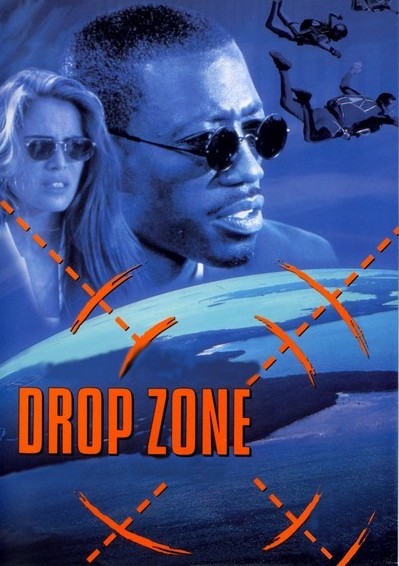Sunday, December 11, 1994.
DROP ZONE. Written by Peter Barsocchini and John Bishop. Based on a story by Tony Griffin, Guy Manos and Peter Barsocchini. Music by Hans Zimmer. Directed by John Badham. Running time: 101 minutes. 14 Years Limited Admission with the B.C. Classifier’s warning "some violence and very coarse language.”
U.S. MARSHAL PETER NESSIP (Wesley Snipes) is in shock.
Earlier this evening, he saw a routine prisoner transfer turn into a mid-air tragedy. An explosion during an apparent skyjacking blew a hole in the side of an Atlanta-bound commercial airliner.
Nessip saw his brother Terry (Malcolm-Jamal Warner) wounded in a shootout, then sucked out into the void. Another 13 people are dead or missing, including their charge, convicted computer criminal Earl Leedy (Michael Jeter).
And now his boss, chief marshal Tom McCraken (Andy Romano), tells him that it's all his fault. FBI investigators are "looking to point the finger at someone, and you and Terry are it."
Nessip knows that's not right. He believes that his brother died attempting to foil an airborne prison break. Against all the evidence, he concludes that white men can jump.
Drop Zone, director John (Stakeout)
(That's okay by me. DC-3s have always been more romantic than Harleys and, in terms of anarchic individualism, throwing yourself at the earth from 15,000 feet has to be the ultimate in one-minute management.)
Badham lets us in on the secret right up front. Leedy has indeed been sprung from custody.
His benefactor is retired Drug Enforcement Agency officer Ty Moncrief (Gary Busey), leader of a Florida-based skydiving team. An immoral entrepreneur, Moncrief plans to sell the government's most precious secrets — the names of its undercover agents — to international drug dealers.
He needs Leedy's data-management skills to break into the DEA's computer files. Together with his team, he intends to jump into the agency's Washington, D.C. headquarters on the 4th of July.
Nessip will piece it together more slowly. Working from a serviceable screenplay by Peter Barsocchini and John (The Package) Bishop, Badham introduces us to the skydiving subculture, a variation on the frontier societies of bikers, surfers and off-duty cops.
Nessip finds an ally in fearless adventuress Jessie Crossman (Yancy Butler), leader of a team of like-minded nuts, and a free-fall Supergirl. The story contains just enough plot to link the film's non-stop aerial stunt work and caper-like incursions into forbidden places.
Throughout, Badharn continues a love-hate relationship with high tech that he's maintained through War Games,
A craftsmanlike adventure, it features the unexciting Snipes as a character more concerned with personal vindication than duty. Reflecting the unhinged mood of the times, Badham shows us a world in which jumping out of planes makes as much sense as anything else.
The above is a restored version of a Province review by Michael Walsh originally published in 1994. For additional information on this archived material, please visit my FAQ.
Afterword: Before taking on the movie beat at The Province, I wrote feature stories for Spotlight, the newspaper’s weekend magazine supplement. Among them was a 1971 cover piece on skydiving that involved me shadowing a particularly brave young woman named Louise who was keen on the experience of free fall over British Columbia’s Fraser Valley. Together with a staff photographer, we drove out to rural Abbotsford, the location of a reputable training park for aspiring sport parachutists.
Although we both took the day-long ground school course — yes, I actually qualified to jump out of that plane — Louise was the one who did the actual deed. Her weekend adventure made for an exciting story, and left me with just enough direct knowledge of the sport to appreciate the courage of Jessie Crossman, actress Yancy Butler’s character in Drop Zone. As it turned out, the free-fall film is less an actual subgenre than a frantic footnote in action movie history.
Hardcore fans cite director John Frankenheimer’s 1969 feature The Gypsy Moths as the first film to celebrate their sport. It starred Burt Lancaster and Gene Hackman as men who “turn on by falling free . . .” Then came 1991, and the release of Point Break, in which Kathryn Bigelow directed Patrick Swayze and Keanu Reeves as rival divers. John Badham’s Drop Zone arrived in 1994, along with Deren Sarafian’s Terminal Velocity, a Charlie Sheen vehicle. Neither film was successful at the box office, and there wouldn’t be another free-fall film until 2000, the year of writer-director Guy Manos's unofficial TV remake of Drop Zone, a Tom Berenger adventure called Cutaway. Finally, 2015 marked the arrival of Eric Core’s Point Break, a remake of Bigelow’s surf-and-sky thriller.
A Bushel of Badham: Today’s five additions the Reeling Back archive celebrate the cinema of John Badham. Included are his 1976 debut feature, The Bingo Long Traveling All-Stars & Motor Kings; the 1981 drama Whose Life Is It Anyway?; the 1986 sci-fi comedy Short Circuit; the 1993 thriller Point of No Return; and the action adventure Drop Zone (1994). And, of course, there is my review of his new book, John Badham on Directing - 2nd Edition (2020).
Wait, There’s More: The six John Badham features previously posted to Reeling Back are his 1979 adaptation of Dracula, as well as Blue Thunder and War Games (both 1983); Also included are the made-in-Vancouver Stakeout (1987), Bird on a Wire (1990) and Another Stakeout (1993).
